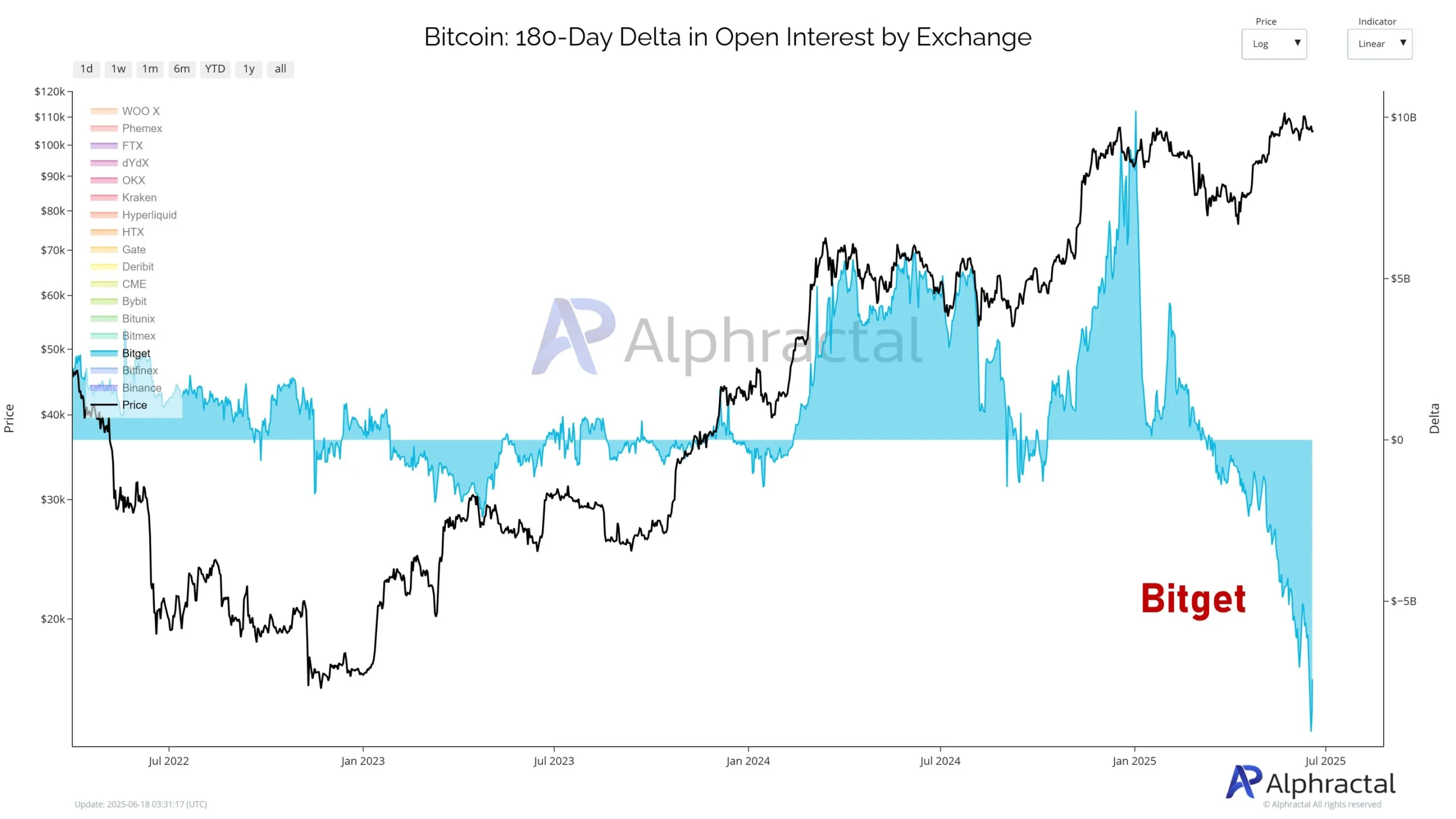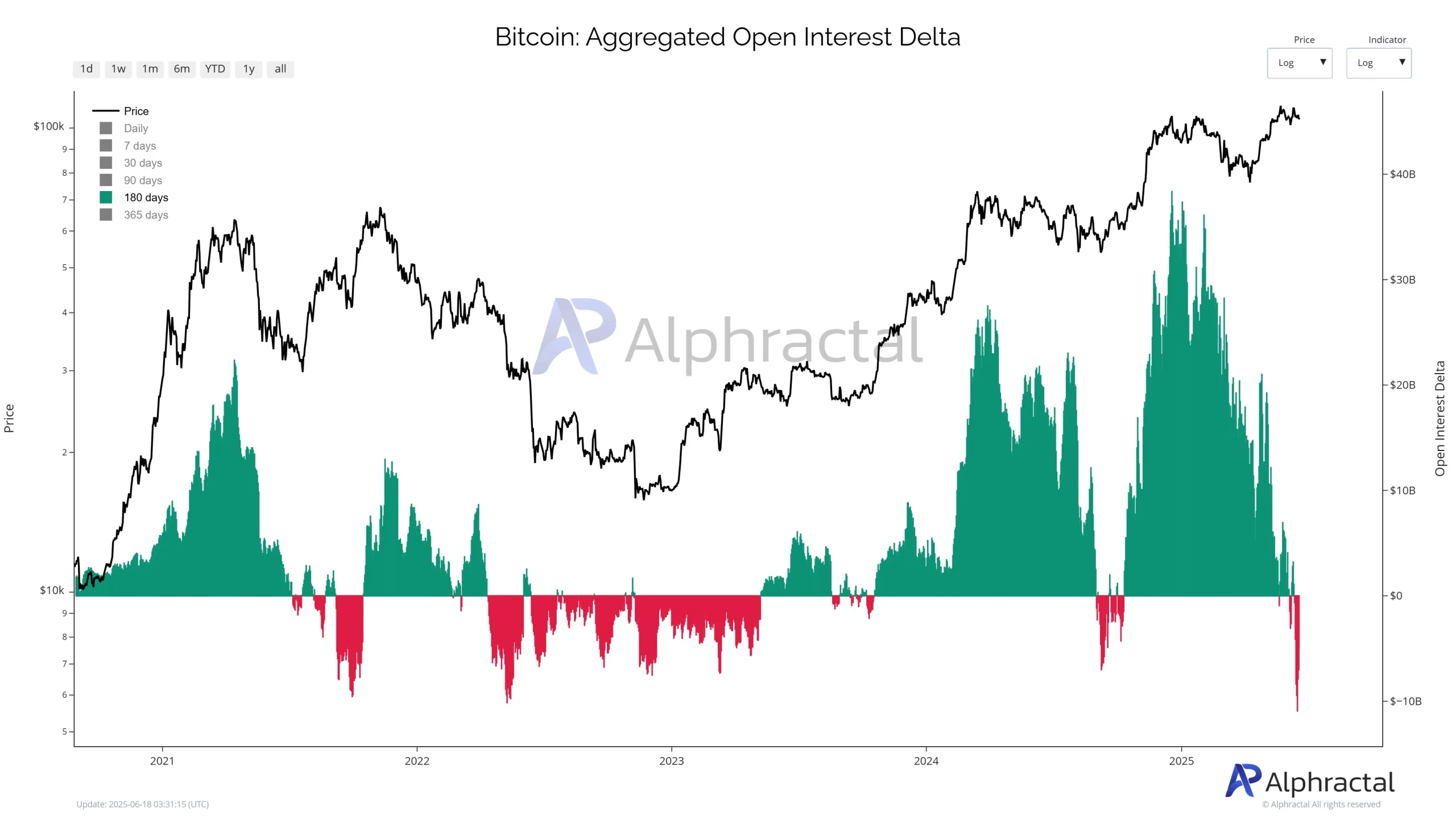Bitcoin Faces Pressure as 180-Day Open Interest Delta Turns Red
Bitcoin's 180-day Open Interest Delta turns negative, raising concerns about market trends and signaling potential price shifts.

Quick Take
Summary is AI generated, newsroom reviewed.
The Negative OI Delta could signal a downturn but might also indicate a local price bottom.
Mixed market sentiment with Gate.io showing growth while Bitget and CME experience OI reductions.
Historical patterns show negative OI Delta often precedes Bitcoin rebounds, although 2022 was an exception.
The sphere of Bitcoin trading is experiencing a real shift at the moment, as the 180-day Open Interest (OI) Delta became negative. This marks a turning point in the market because OI Delta is one of the key indicators that reflect market opinion and tendencies. Over the last six months, the leveraged positions that were closed have exceeded those that were opened, resulting in the OI Delta moving into the negative side. This situation is already prompting analysts to debate what it may portend for the future of Bitcoin’s price behavior.

Significant positions that have been relocated to major exchanges, including Bitget and CME, have also led to the negative OI Delta. Bitget was solely responsible for eliminating an enormous 7.42 billion, and CME followed with the immediate elimination of 3.93 billion. This movement of open interest is expected to indicate a correction or a staged series of volatility, as traders exhibit caution due to uncertainty.
On the other side, we have exchanges such as Gate.io that are demonstrating a slightly different trend. Gate.io has experienced a growth in open interest of $3.2 billion, indicating that some market players are betting on an alternative outcome and making future positioning to reflect it. These conflicting actions on both sides of the exchange are indicators of the diverging market mood, with some market players hedging against a possible meltdown and others still holding onto their bullish stances.
Historical Context: What Does the Past Tell Us About Negative OI Delta?
To get a greater appreciation of what this adverse change in the OI Delta implies, we may turn to historical data as a point of reference. This is the case because, in 2021, when the OI Delta turned negative, after 180 days, Bitcoin was being priced between the range (31K to 41K) prior to the historic all-time high of (69K). This suggests that a negative OI Delta could have indicated a local minimum in the price of Bitcoin in the past, depicting price stabilization prior to a starkly bullish run.

Each time the OI Delta became negative in both 2023 and 2024, the kicker was that it marked a local bottom in Bitcoin, which means the crunch on the price of Bitcoin might have been passing. Although history says that there has been a bullish shift after such negative OI Delta durations, it should be remembered that there was an exception in the year 2022.
In 2022, a severe decline in OI marked one of the lowest stages of the Bitcoin bear market, demonstrating that markets can act arbitrarily and that historical signs do not always necessitate a follow-up. This irregularity serves as a valuable lesson in trading, highlighting that a negative OI Delta may have been a historical indication of price bottoming; however, there are also situations when it can be aligned with more significant market realities.
What’s Next for Bitcoin: Key Takeaways for Traders
To Bitcoin traders, the big question is whether the OI Delta would once again turn positive soon, and this would be an indication of a new rally. When the OI Delta moves back to the green, it may indicate that Bitcoin is on a bull run again, and the conditions may be ripe for setting new highs within the following months. However, on the contrary, if the current pattern of negative OI Delta continues, it may be possible that the downward pressure on Bitcoin is not yet over, and we may need to endure more precarious trading.
Market analysts are advised to remain vigilant and continue to closely monitor liquidity and open interest (OI) patterns. Such indicators are essential in recognizing top-dovers in the market, and those traders who can recognize the shift as early as possible may take advantage of the next big shift. As it is customary, anything related to Bitcoin trading is full of twists and turns, and it is in the interest of anyone who deals in such an instrument of exchange to remain alert and be knowledgeable of the matters that have a bearing on the market situation.
To sum up, the latter adverse trend in the 180-day OI Delta marks a change in Bitcoin that begs a question about the market trend. It will be up to the traders to closely monitor the data to see whether this will lead to another phase of the market or if it was just a passing trend. As history tells, the situation remains fluid, and it is unclear what Bitcoin will do next.
Follow us on Google News
Get the latest crypto insights and updates.


